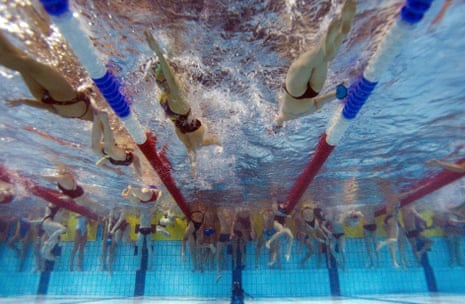It is an antisocial act that normally goes under the radar, but many swimmers have long suspected the truth: people are peeing in the pool.
Now scientists have been able to confirm the full extent of offending for the first time, after developing a test designed to estimate how much urine has been covertly added to a large volume of water. Regular swimmers with a keen sense of hygiene may wish to stop reading now.
The test works by measuring the concentration of an artificial sweetener, acesulfame potassium (ACE), that is commonly found in processed food and passes through the body unaltered.
After tracking the levels of the sweetener in two public pools in Canada over a three-week period they calculated that swimmers had released 75 litres of urine – enough to fill a medium-sized dustbin – into a large pool (about 830,000 litres, one-third the size of an Olympic pool) and 30 litres into a second pool, around half the size of the first.
Lindsay Blackstock, a graduate student at the University of Alberta, Edmonton, and lead author, said: “Our study provides additional evidence that people are indeed urinating in public pools and hot tubs.”
Although the researchers were unable to confirm exactly what fraction of visitors were choosing to quietly relieve themselves in the water rather than making the shivery trip to the changing rooms, the results suggest that the urine content was being topped up several times each day.
“We did not monitor the number of pool users over the three week time period ... so there is no way we could estimate the number of individual urination events per day,” said Blackstock.
The findings make for unwelcome reading, but swimmers might find some comfort in the measurements from eight hot tubs, which were found to have far higher urine levels. One hotel Jacuzzi had more than three times the concentration of sweetener than in the worst swimming pool.
In total, the team sampled 31 different pools and tubs in two Canadian cities and found ACE to be present in 100% of the samples, with concentrations up to 570 times the background level in tap water samples. They used the average ACE concentration in Canadian urine to convert their measurements into approximate volumes of urine.
“We want to use this study to promote public education on appropriate swimming hygiene practices,” said Blackstock. “We should all be considerate of others and make sure to exit the pool to use the restroom when nature calls.”
While most people, beyond early childhood, would not admit to using their local swimming pool as a giant communal toilet, the results are not entirely surprising. In one anonymous survey, 19% of adults admitted to having urinated in a swimming pool at least once. And professional swimmers have confessed to being among the most regular offenders.
Ahead of the London 2012 Olympics, the US swimmer, Ryan Lochte, said: “I think there’s just something about getting into chlorine water that you just automatically go,” and his team-mate, Michael Phelps, agreed it was acceptable behaviour. “I think everybody pees in the pool,” he said. “Chlorine kills it, so it’s not bad.”
However, while urine is sterile, compounds in urine, including urea, ammonia, and creatinine have been found to react with disinfectants to form byproducts known as DBPs that can lead to eye and respiratory irritation. Long-term exposure to the compounds has been linked to asthma in professional swimmers and pool workers.
In the future, the scientists suggest it may be possible to use ACE as a test to ensure that urine in pools is kept to a hygienic level. Contrary to the warning many children are given – that a coloured cloud will appear around them if they pee – there is currently no urine indicator dye that could be used in a pool.
“This is a myth probably used to scare children, and adults, into using proper hygiene practices for fear of public humiliation,” said Blackstock.
The findings are published in the American Chemical Society journal, Environmental Science & Technology Letters.

Comments (…)
Sign in or create your Guardian account to join the discussion